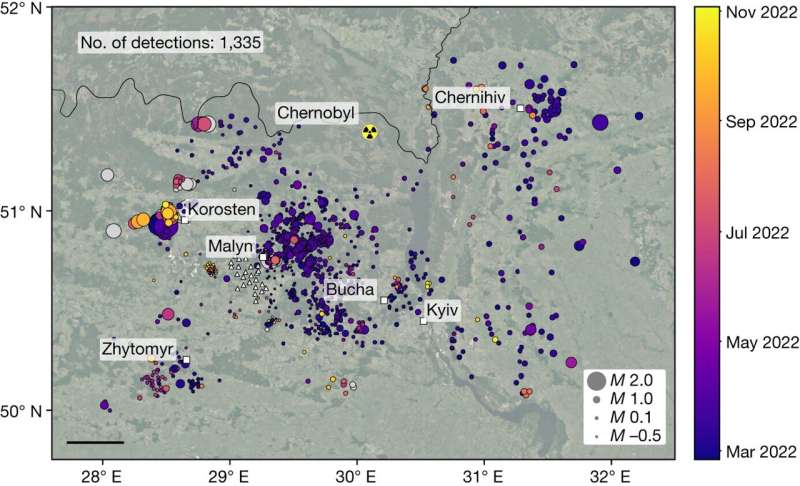September 7, 2023 report
This article has been reviewed according to Science X's editorial process and policies. Editors have highlighted the following attributes while ensuring the content's credibility:
fact-checked
peer-reviewed publication
trusted source
proofread
Tracking big explosions in the Ukraine war using earthquake sensing technology

A team of seismologists at NORSAR, Kjeller, Norway, working with a colleague from the State Space Agency of Ukraine, has found that it is possible to track big explosions associated with the war in Ukraine using earthquake sensing technology.
In their study, reported in the journal Nature, the group used seismometers to monitor the progress of a war after analyzing data from seismometers situated around Ukraine's nuclear power plants soon after the Russian invasion began. Nature has also published a Research Briefing summarizing the work done by the team in the same journal issue.
One of the things that the invasion of Ukraine by Russia has taught the world is that modern warfare is unlike wars waged in past centuries. New technology has led to the addition of such elements as drones carrying explosives and shoulder-fired, tank-destroying weapons. In this new effort, the researchers found that other elements of a modern war may involve use of peacetime tools such as seismometers.
Over the past several decades, scientists in Ukraine have installed a large number of seismometers around its nuclear power plants. The sensors, it was hoped, would alert authorities of an earthquake or an explosion. Shortly after Russia began its invasion, scientists in Ukraine began monitoring the seismometers looking for evidence of Russian attacks on such plants. They discovered that they could detect explosions at more distant sites as Russia began lobbing bombs and missiles around the country.
As the invasion progressed, the research team began using software to analyze the data from the seismometers to learn more about the nature of the explosions, such as their size and power. In some cases, the researchers found enough information to make guesses about the source of an explosion, such as the type of bomb that was detonated.
The researchers suggest that seismic monitoring could be used as a valuable tool in future wars between countries that have an existing base of installed sensors.
More information: Ben D. E. Dando et al, Identifying attacks in the Russia–Ukraine conflict using seismic array data, Nature (2023). DOI: 10.1038/s41586-023-06416-7
Monitoring an active war zone in Ukraine using seismic data, Nature (2023). DOI: 10.1038/d41586-023-02454-3
Journal information: Nature
© 2023 Science X Network



















